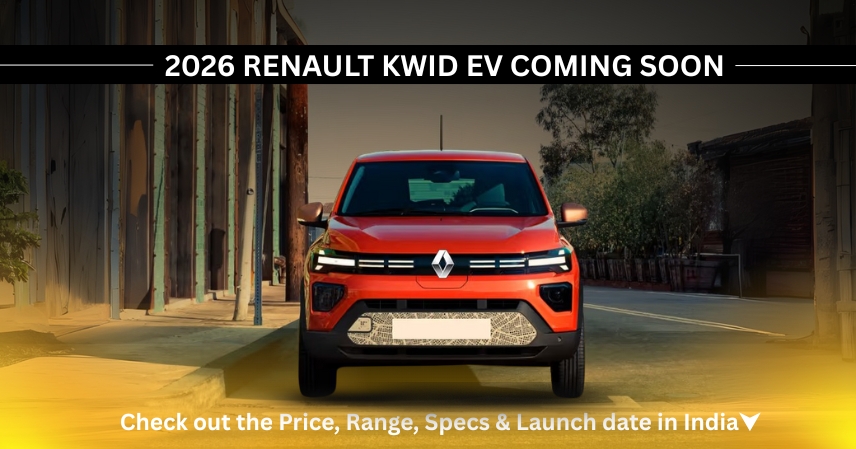Setting the Stage: Authority and Expertise
There is growing excitement in India about the upcoming Renault Kwid EV, an electric version of the popular petrol Kwid—closely related to Europe’s Dacia Spring EV. Renault is positioning this model as an affordable, city-friendly EV that could transform the entry-level electric car market in India. This article provides a detailed look at what the 2026 Renault Kwid EV promises, including new motor options, faster charging, design updates, expected pricing, and how it compares to other cars in its class. All information is sourced from credible news outlets, spy shots, and Renault’s Dacia partnership to give you a trusted overview ahead of the official launch
What’s New in the 2026 Renault Kwid EV?
More Powerful Motor Options
Two likely motor variants:
- ~44–45 hp (≈33–44 kW)
- ~64–65 hp (≈47–50 kW)
Torque Output:
- Electric 45: ~125 Nm
- Electric 65: ~113 Nm
Acceleration:
- 0–100 km/h in under 14 seconds for the higher-powered version
- Improvements to Battery, Charging, and Range
- Battery: 26.8 kWh lithium-ion
- Claimed Range: ~220–225 km (WLTP)
Charging:
- 7 kW AC home charger
- 30 kW DC fast charger (20% to 80% in about 45 minutes)
- Design, Features, and Practicality
Exterior:
- Modern front end, EV-style closed grille, LED DRLs, Y-shaped tail lights, body cladding
Interior:
- 10-inch touchscreen infotainment system
- 7-inch digital instrument cluster
- Power windows, possible automatic climate control
- Higher trims may include Vehicle-to-Load (V2L) feature
Practicality:
- Boot space: ~308 liters
- Compact size ideal for city driving
- Driving Experience and Performance
- Two drive gradations based on motor:
- Lower variant (44–45 hp): Ideal for daily city driving
- Higher variant (64–65 hp): Better for highway
Ride Comfort and Stability:
- Expected suspension upgrades
- Possible anti-roll bar integration for improved cornering stability
- Reliability of Information
- Verified by multiple test mules sighted in India (photos and in-person)
- Renault’s ownership of Dacia and the global presence of the Spring EV make specs reliable
- Sources: NDTV, CarDekho, The Economic Times, and other respected news outlets
Warnings and Uncertainties
- Final specs not officially released by Renault India—current info based on leaks, spy shots, and Dacia Spring EV comparisons
- Differences in Indian market specs possible (battery, motor, range, etc.)
- WLTP range figures (220–225 km) may be lower in real-world Indian conditions
- Price estimates (₹7–9 lakh ex-showroom) may vary by region, import taxes, and features
- Specification changes possible based on safety standards, ADAS, and trim levels
- Expected Launch and Market Position
- Launch Window: Late 2025 to early 2026 (some say as late as end of 2026)
Price:
- Base models expected between ₹7–9 lakh ex-showroom
- Higher variants will cost more
Main Competitors:
- Tata Tiago EV
- MG Comet EV
- Citroën eC3
- Potentially Punch EV and others
- Comparison with Dacia Spring EV and Upgrades
- Similar architecture and features to Dacia Spring EV
Key improvements:
- More powerful motor options
- Faster DC charging
- Better battery chemistry and safety
- Stability upgrades (suspension, anti-roll bars)
Frequently Asked Questions (FAQs)
- What is the expected range of the 2026 Renault Kwid EV in India?
The 26.8 kWh battery is expected to deliver 220–225 km (WLTP). Real-world range may be lower.
- How quickly will it charge?
With a 30 kW DC fast charger, 20% to 80% can be charged in about 45 minutes; a 7 kW AC charger is for slower, home charging.
- What kind of power and acceleration can be expected?
Two motor options: ~44–45 hp and ~64–65 hp. The faster variant can do 0–100 km/h in under 14 seconds.
- What is the expected price in India?
Base models should be priced between ₹7–9 lakh (ex-showroom); higher trims will cost more.
- When will it launch?
Estimated launch is late 2025 or early 2026, but could be delayed to the end of 2026.
- Who are its main competitors?
Tata Tiago EV, MG Comet EV, Citroën eC3, and other affordable EV hatchbacks.
Why the 2026 Kwid EV Matters
Accessibility and Market Impact
- If Renault meets its pricing goal, the Kwid EV will make EVs accessible to more Indian consumers.
- Faster charging, improved batteries, and local manufacturing will enhance reliability and affordability.
- Will support India’s EV adoption goals and stricter emissions standards.
Considerations and Risks
- Localization: Local manufacturing may impact costs due to duties and supply chain variability.
- Charging Infrastructure: DC fast charging network is still limited in India.
- Battery Durability: Heat, road conditions, and battery type (Li-ion vs. LFP) affect long-term performance.
- Safety Standards: Indian regulations (airbags, crash testing) may alter specs and costs
Final Thoughts
The Renault Kwid EV 2026 is shaping up to be a strong competitor in India’s entry-level electric vehicle market. Its improved motors, fast charging capability, practical range, and competitive pricing make it a compelling choice for city EV buyers. While some details remain unconfirmed, Renault’s momentum and the Kwid’s reputation suggest this model could help popularize affordable EVs and push competitors to improve their offerings. The wait may well be worth it for buyers seeking a reliable, budget-friendly electric hatchback.

